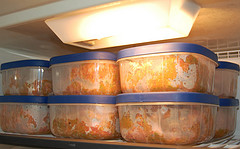Due to pet food recalls, increases in allergies among dogs, and the cost of commercial dog food rising, many dog owners are contemplating homemade dog food – whether raw or cooked – for their furry best friend. And many say it is healthier for your dog than traditional kibble and wet food (depending on the brand). But is it really best? Do dog owners know how to feed their dog’s correctly?
Emily Lagasse is Founder and CEO of FedWell Pet Foods, which is based on the home-cooked diet that healed her dog after he became ill on the traditional dog food diet (check out their Kickstarter campaign). Lagasse answered our questions about raw and home-cooked dog food so you can make a more informed choice about what to feed your dog.
What are the pros to home cooked dog food?
When choosing a dog food it’s important to consider the same principles that you consider when making healthy eating choices for yourself. Namely, you want to choose a food that has high quality, nutrient-dense, digestible ingredients that are minimally processed.
Home-cooking allows pet parents the opportunity to hand-pick the produce they feed their dog and oversee the production from start to finish.
Raw feeding offers the same potential benefits– depending on if it is a commercial raw diet or BARF diet– it can also be made with high quality ingredients that are minimally processed.
What are the cons for both?

Home cooking for dogs is very time intensive from research and education to preparation and storage of food.
It also requires lots of freezer and refrigerator storage space!
Traveling with dogs on a home-cooked or raw diet is also tricky.
Raw food especially poses the additional potential hazard of harmful bacteria and pathogens that can contaminate kitchen spaces and dog bowls when not cleaned properly.
Can you harm your dog feeding home-cooked or raw foods?
There are potential risk factors with any dog food diet, whether you purchase it at a store or prepare it yourself. When preparing a home-cooked diet, it is of absolute importance to understand which ingredients are toxic to dogs as well as what nutrients your dog requires and the best produce to provide required nutrients.
When feeding raw, those same rules apply, with the addition of thorough cleaning of surfaces raw food touches during preparation and after feeding.
Is it possible to get a completely balanced meal from home?
While it is possible to get a completely balanced meal from home, it requires a lot of knowledge and background training in nutrition and anatomy.
On the other hand, are any store-bought foods really balanced?
Many store-bought foods are considered “complete and balanced” by the American Association Feed Control Officials (AAFCO), but what is important to notice is how companies are reaching those target nutrient levels. If an ingredient label includes many synthetic vitamins, you can be assured that the ingredients are poor quality and processing is high making the addition of synthetic vitamins necessary. These synthetic vitamins are more difficult for dogs to absorb and process, making it less desirable.
What about cost?
In addition to the cost of groceries to cook for dogs at home, there is also a huge time cost in preparation. It is possible, however, to find deals on certain produce and meats, especially at farmer’s markets.
If a dog owner is interested in cooking homemade meals, where do they start? How do they know what to feed their dog?
There is a lot of good information out there, but also a lot of poor information out there. The best way to start would be by adding a small amount of steamed veggies to a dog’s kibble at meal time while educating yourself on the array of nutrients dogs require and the combination of foods that provide those nutrients.
What about if they want to start preparing raw?
To start introducing raw food to dogs, you can start with raw bones and chicken necks as treats, also while educating yourself on nutrient requirements and keeping your kitchen and dogs safe while feeding raw.
The Bottom Line
Regardless of what you decide to feed your dog, your vet should be involved. Talk to them about your dog’s overall health, dietary needs and restrictions, and then come up with the right diet for your dog. Just like people, no two dogs are the same.
About the Author
Based in Wilsonville, Ore., animal lover Kristina N. Lotz is a Certified Professional Dog Trainer – Knowledge Assessed (CPDT-KA) and works as a full time trainer. She is the founder of, A Fairytail House, a unique all-positive all-sport dog training facility that helps rescue dogs in her area and provides free seminars and training classes for the community. In her spare time, she trains and competes in herding, agility, obedience, rally, and conformation with her Shetland Sheepdogs. She smartly married a Veterinary Technician, who helps keep the fur kids happy and healthy, and provides a quick resource for articles.
 Toledo, United States.
Toledo, United States.